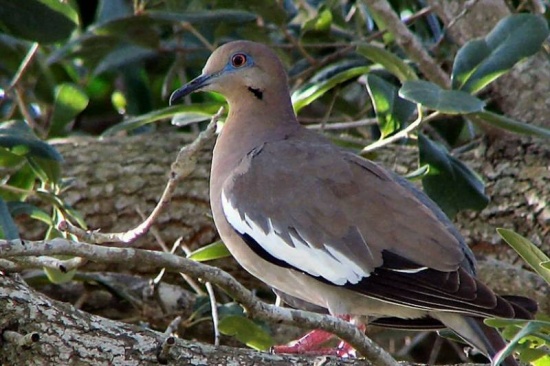- Zenaida asiatica
Identification
Male 27–31 cm (10½-12¼ in); Female 25–29·5 cm (9¾-11½ in)
In flight is mostly brown with dark flight feathers and a very conspicuous patch of white that encompasses the outer lesser-coverts as well as the greater-coverts on the upper wing; the tail also shows some white near the tip of the tail feathers. The white on the wing can often be seen along the lower edge of the folded wing. Legs are red and the bill black. In the head there is a black mark along the lower edge of the auriculars, red eye surrounded by blue, and the crown has a purple sheen that is repeated, if less strongly, on the neck.
Distribution
White-winged Dove is found from California to Texas through Central America to Panama and additionally in the Caribbean east to the Lesser Antilles. Range is expanding both northwards and eastwards.
Taxonomy
Previously, Pacific Dove ( Zenaida meloda ) was considered conspecific with White-winged Dove.
Subspecies
There are 3 subspecies[1]:
- Z. a. mearnsi:
- Arid southern California, North Mexico, Arizona, western Mexico; Tres Marías Island
- Z. a. asiatica:
- Arid southern Texas to Nicaragua; West Indies
- Z. a. australis:
- West Costa Rica to western Panama
The first two subspecies have both expanded their range into the same area of northern Texas and this has lead to mixing of the two.
Habitat
Mostly seen in open areas at the edges of scrub, often in association with human habitation.
Behaviour
This species is able to perform long distance excursions as a single bird, but in areas where the species is more common, it is often seen flying around in flocks.
Diet
Their diet consists mostly of seeds such as millet. They also eat some mast and fruit.
References
- Clements, J. F., T. S. Schulenberg, M. J. Iliff, S. M. Billerman, T. A. Fredericks, B. L. Sullivan, and C. L. Wood. 2019. The eBird/Clements Checklist of Birds of the World: v2019. Downloaded from http://www.birds.cornell.edu/clementschecklist/download/
- Schwertner, T. W., H. A. Mathewson, J. A. Roberson, and G. L. Waggerman (2020). White-winged Dove (Zenaida asiatica), version 1.0. In Birds of the World (A. F. Poole and F. B. Gill, Editors). Cornell Lab of Ornithology, Ithaca, NY, USA. https://doi.org/10.2173/bow.whwdov.01
- PRUETT, C.L., S.E. HENKE, S.M. TANKSLEY, M.F. SMALL, K.M. HOGAN, AND J. ROBERSON. 2000. Mitochondrial DNA and morphological variation of White-Winged Doves in Texas. The Condor 102:871-880.
Recommended Citation
- BirdForum Opus contributors. (2024) White-winged Dove. In: BirdForum, the forum for wild birds and birding. Retrieved 27 July 2024 from https://www.birdforum.net/opus/White-winged_Dove
External Links
Search the Gallery using the scientific name:
Search the Gallery using the common name:
GSearch checked for 2020 platform.






